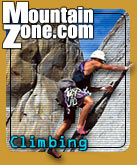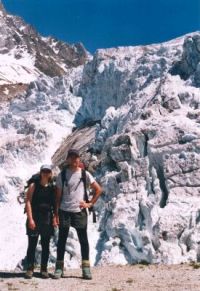
|
Chasing Scarves and Jumping Crevasses Discovering Alpinism on the Massif du Mont Blanc August 11, 2004
Pages »1 2
The sun had risen well into the sky, but as yet there was no repeat of the baking temperatures of the previous day due to a stiff breeze sweeping down from the peaks behind us. Already tired from the climb over the Col du Chardonnet which had been a pretty decent uphill hike with about 800m (2600 ft) altitude gain, we set out fairly slowly over the upper Saleina Glacier. The snow was soft, deep and wet and I longed for the hard-frozen surfaces of the pre-dawn climb. How could a practically flat stroll be this much hard work? We were moving at what seemed like a snail’s pace and still breathing hard in the rarefied air of 3000m (9850 ft) plus. We stopped for a breather and watched Marco and Susannah, mere specks in the huge white canvas of the Aiguille d’Argentiere’s north face. From our perspective the wall looked nigh on vertical and impossibly immense, yet they were making steady upwards progress. We, on the other hand, had a long way to go and weren’t getting there very quickly. As we stood there watching, the wind suddenly whipped the scarf off my neck and dragged it away across the glacier. I’d like to say that I’m not very materialist (except when it comes to some of my outdoor gear), but this wasn’t just any scarf. It was a hand-painted silk scarf that I’d found in the markets in Kuala Lumpur and had worn on a harrowing overland adventure to Morocco and back. It was a scarf with history. Losing it would have been a tragedy. Roger, valiant and certainly the stronger of us, started racing off after it. However, being tied to him I was obliged to race off after Roger. Well, racing might not be the best term to describe it. To an onlooker it would have been more like frantic stumbling through the snow, with regular short pauses for catching our breath. After an agonizing run Roger made a heroic dive worthy of any Kiwi rugby fan and landed his ice axe squarely on top of the scarf before it could take off once more in the wind. We lay in the snow, panting. "Thanks," I said. Roger grinned, proud of himself. Eventually we picked ourselves up and started making our way across the glacier again towards the next col, the Fenętre de Saleina. The snow conditions improved on the other side of the Fenętre de Saleina but our energy levels were not on par. By the time we had made it over the Col du Tour we were having trouble keeping our footing on the slippery, well-trodden path to the refuge. We were falling over just through tiredness. It was a relief to finally sit at the refuge and drink sugary drinks in an attempt to regain a bit of energy. At that point we believed that the hard bits were behind us. We’d been walking for about 12 and a half hours and we were looking forward to a shower and a long sleep. Roger called Marco and told him we’d be down soon.
Because the cable cars weren’t running we were faced with a walk all the way down into the valley, but the most direct trail looked pretty short. On the map, the trails are marked with lines and dots. Dots, in the legend are the 'hard part of [the] hiking trail'. The most direct trail had lots of dots. I guess that shouldn’t have been surprising really, considering how crowded the contour lines are there. But I’d walked on dots before. They weren’t so bad. At least we were off the snow and ice. We followed the trail down the moraine wall and reached a section where it delicately traversed near-vertical terrain. The consequences of a misstep on this vertiginous goat track were unthinkable. It was just a short distance as the crow flies, but we still had about 1250m (4100 ft) of altitude to lose. After the goat track the trail took a sudden plunge of 500m (1640 ft) of altitude over a distance of just one km (0.6 miles) and at times resembled downclimbing more than walking. The effort required to pick our way delicately and safely down the trail was really digging into our final reserves and made the tour over the cols seem particularly easy and sans risk in comparison.
By the time we made it to Le Tour we had been on the go for 16 hours and we couldn’t find Marco and Susannah. We phoned them. "Where ARE you guys?" Marco asked. Well, uh, it had taken us a bit longer than expected... We’ve climbed a few peaks in the Alps since then, but the tour we had done which covered so much ground amongst the peaks of the Massif du Mont Blanc would easily remain our most memorable alpine excursion to date. Recently, we were back in the Chamonix Valley just to soak up the atmosphere and breathe some fresh mountain air. We took the cable car up to a vantage point on the Aiguilles Rouges, the opposite side of the valley to the Massif du Mont Blanc, and poured over our map, checking out the peaks and landmarks. The Col du Chardonnet peeked out at us from behind the striking Aiguille Verte, reminding us of our tour. An elderly French lady came over and asked if she could look at our map. She must have been in her mid seventies at least. She told us she knew the area well, but hadn’t brought her own map because it was just by chance that she was taking a day out there. Her father had made a first ascent of the Aiguille du Chardonnet back in 1927. I looked at the formidable rocky spire to the left of the Col du Chardonnet and couldn’t help but be impressed. She herself had only climbed 'a couple of peaks,' and she seemed slightly envious that we had done Les Trois Cols. She had always wanted to do it as a ski tour, she said. Then, after one more glance across the valley, she left to rejoin her friends.
-- by Pam Inverarity
|
||||||||||||||||

